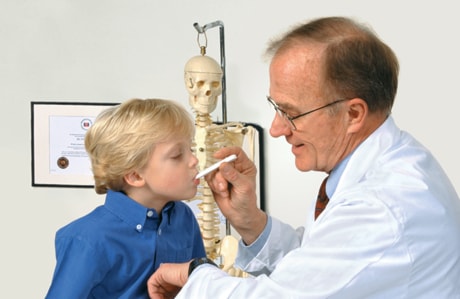Parents go to their pediatrician looking for advice about the care and safety of their kids, but there may be times when they’re being served up an old wives’ tale or a dangerous myth, a new study suggests.
Lead investigator Dr. Andrew Adesman set out to determine if pediatricians would agree with certain incorrect statements or old wives’ tales, such as chicken pox is not contagious before the rash appears, eating chocolate causes acne or listening to Mozart will make a baby smarter.
Adesman and his wife are both Ivy League-educated pediatricians, he said, and even they found themselves occasionally buying into some parenting myths as they raised their three children.
For example, they wouldn’t let their kids swim until 30 minutes after eating. “I remember with my oldest daughter taking a bandage off a wound letting it get some air and breathe at night,” he said as he discussed his findings, presented Sunday at the Pediatric Academic Societies meeting in Vancouver.
“And so those are examples of two myths which are still very, very popular and even some pediatricians are getting them wrong. Interestingly. . . in terms of wounds healing quicker when exposed to air, one-third of pediatricians thought that that was true, when the answer is it’s best off leaving the wound covered.”
Adesman and his team sent out questionnaires to 5,000 board-certified American pediatricians, and they received responses from 1,002 doctors.
Thirty-four myths and 14 true statements were included, and the doctors were asked to what extent each of the statements was true, likely true, unsure, likely false or false. The responses of doctors who went to the Internet or searched through books for answers were disqualified.
Adesman, a pediatrician at the Steven and Alexandra Cohen Children’s Medical Center of New York, said most of the old wives’ tales are benign, or wouldn’t hurt anybody.
But he also included what he refers to as the “dangerous dozen” — 12 health beliefs or misconceptions that pediatricians might subscribe to.
More than three-quarters of the pediatricians surveyed mistakenly endorsed one or more dangerous parenting myths as being true. And 13 per cent got three or more wrong.
“So, for example, when we asked the question whether it was OK for honey to be given to babies under six months of age, the very good news is 97 per cent of pediatricians knew that that was not appropriate, but three per cent thought it was,” Adesman said, adding that honey poses a risk of botulism poisoning.
One-third of the doctors said a burn can be treated with ice, when in fact there would be a risk of injury to the skin. And one-third said it’s safe to put a baby down to sleep on his side, when in fact that’s not advised because of the risk of crib death.
Five per cent of respondents said kids over six can be given Aspirin for fever.
“Aspirin has been associated with Reye’s syndrome — Reye’s syndrome is a very severe condition and so Aspirin really shouldn’t be used with young children, even those in the five-to-eight (age) range,” Adesman said.
Five per cent also agreed it would be OK to place a soft object in a child’s mouth during a seizure.
“The reality is it’s not a good idea ’cause what happens at the very beginning of a seizure is when the teeth start to clench down, so by the time you’re seeing the seizure it’s too late to prevent injury to the tongue — it’s not that common an occurrence,” he explained.
“And by trying to open the mouth, you’re just going to increase the risk of either hurting yourself or possibly doing some damage to the teeth.”
In analyzing the data, the researchers found that pediatricians who had not raised kids themselves were somewhat more likely to subscribe to old wives’ tales.
In terms of the dangerous dozen, there was also a difference.
“We found that those who were either long in the tooth or wet behind the ears, who practised less than five years and more than 30 — both those two cases — that there were a higher rate of pediatricians subscribing to some of these dangerous health beliefs.”
Adesman said most pediatricians get most of the information right, “but I think we need to raise the bar.”
Adesman is the author of BabyFacts: the Truth about Your Child from Newborn through Preschool.
Those who wish to test their knowledge of parenting myths can go to his website www.BabyFacts.com.
